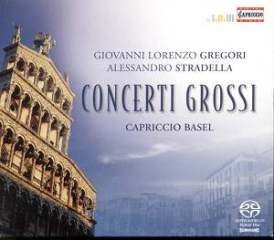Gregori, Stradella - Concerti Grossi (2006)
Gregori, Stradella - Concerti Grossi (2006)

Gregori, Giovanni Lorenzo 1. Concerto grosso No. 1 in C Major, Op. 2 00:03:28 2. Concerto grosso No. 2 in D Major, Op. 2 00:03:38 Stradella, Alessandro 3. Sonata due cori in D Major 00:01:58 Gregori, Giovanni Lorenzo 4. Concerto grosso No. 3 in B - Flat Major, Op. 2 00:04:08 5. Concerto grosso No. 4 in A Major, Op. 2 00:05:19 Stradella, Alessandro 6. Sinfonia No. 2 00:01:41 Sinfonia No. 1 7. I. Allegro 00:01:58 8. II. Andante 00:03:56 9. III. Allegretto 00:01:21 Gregori, Giovanni Lorenzo 10. Concerto grosso No. 5 in B Minor, Op. 2 00:04:00 11. Concerto grosso No. 6 in A Minor, Op. 2 00:02:59 12. Concerto grosso No. 7 in E Major, Op. 2 00:04:26 Stradella, Alessandro Sonata di viole in D Major, "Concerto-concerto grosso" 13. I. Adagio - Allegro - Adagio 00:02:18 14. II. Allegro 00:01:51 15. III. Adagio - Allegro 00:01:19 16. IV. Allegro 00:01:56 Gregori, Giovanni Lorenzo 17. Concerto grosso No. 8 in D Major, Op. 2 00:05:17 18. Concerto grosso No. 9 in G Minor, Op. 2 00:03:37 19. Concerto grosso No. 10 in A Major, Op. 2 00:05:02 20. Sinfonia 00:04:01 Capriccio Basel (Ensemble)
Gregori was a violinist and for many years active in Lucca. But it’s as Maestro di cappella that he earned his greater celebrity, one cemented through his textbook on Gregorian chant and a more general treatise on music. Like many another Italian composer he was drawn to French dance music and songs, which he attempted to synthesise with his own Italianate muse.
His Concerti grossi followed in the wake of the explosion of concertante music by such as Torelli. However Gregori was keen to make explicitly clear that he wanted the term Concerto grosso to mean that subordinate players were to act as “reinforcements” for the principal string players. Thus any genuinely solo passages are rare, Gregori preferring massed attacks and string dialogues to any embryonically soloistic role for section leaders.
And that’s how it’s played here. The writing embraces considerable vibrancy of attack with typically Italianate control of staccati. This last is something of a favoured device of his. The opening of the C major judders briefly, a ploy to which he returns in the B flat major. He utilises in both cases the Adagio, e Staccato marking to generate considerable rhythmic compression. He is not afraid to embrace a degree of harmonic richness nor – within a rather confined compass – to spin a warm Largo; the D major [No.2] is an especially compelling aspect of this facet of his compositional art.
He seems to have been aware of his contemporaries’ work in instrumental music – the A major for example has a distinctly Torellian gravity to it. He employs the organ in the A minor [No.6] and varies textures and instrumental textures with surety. A rather warmer, more uplifting form of his favoured staccato appears in the opening Posato of the final concerto, No.10.
Interspersed between the concertos are some attractive works by Stradella, whose ensemble sonatas, whilst brief, are also pithy and lyrical. The Sonata di viole is probably the most attractive with its fine balance between solo and concerto weight of tone and texture. And the Sinfonia [track 20] is a genuine delight.
The SACD has captured Capriccio Basel with fidelity; they’re an original instrument ensemble with a 10-3-2-1 line up. Sometimes I felt them pulling away too quickly – this is very much a mater of taste but I felt the second movement Presto of No.1 for example was too fast. Demerits must include no tracking of individual movements. ---Jonathan Woolf, musicweb-international.com
download (mp3 @320 kbs):
yandex 4shared mega mediafire zalivalka cloudmailru oboom uplea
Last Updated (Thursday, 24 September 2015 16:21)








